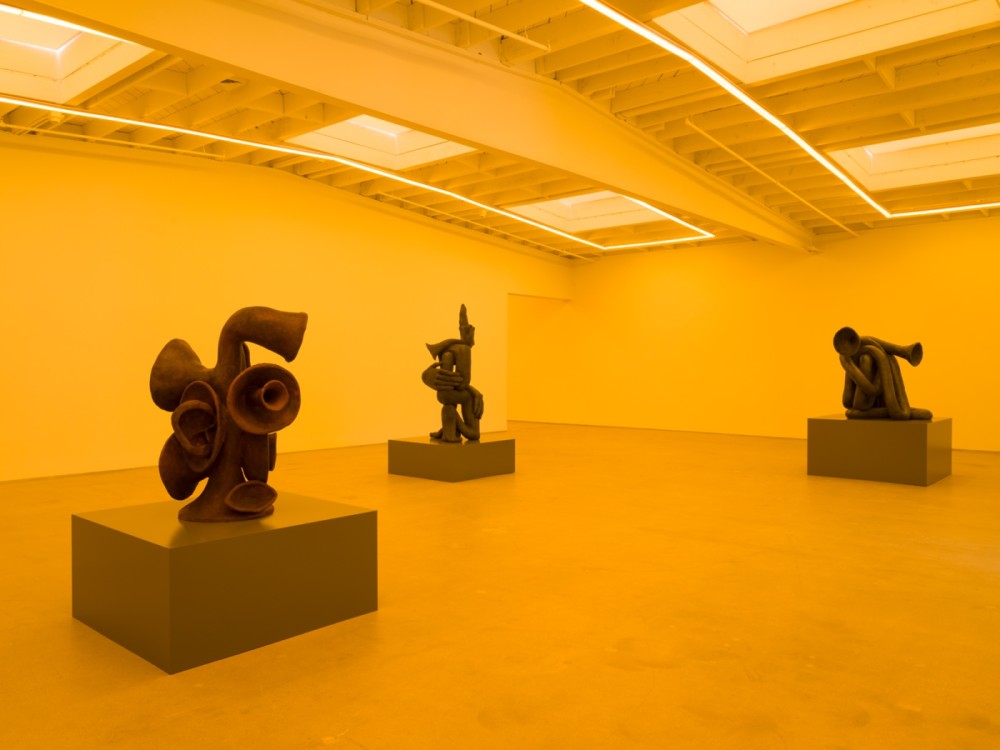
Woody De Othello: Tuning the Dial
Karma presents Tuning the Dial, Woody De Othello’s first exhibition in Los Angeles, open from February 19 to April 5 at 7351 Santa Monica Boulevard.
For Tuning the Dial, Othello creates an offering for reflection through an immersive installation of ceramic and bronze sculpture, works on paper and canvas, light, sand, and a commissioned ambient soundscape titled Vire Sab—“turning sand” in Haitian creole—by Othello’s frequent collaborator Cheflee. The title of the show is inspired by the invisible frequencies that we carry in our emotions as humans. “Emotion is energy in motion,” explains Othello, “felt rather than seen, almost like wave lengths or sound reverberations.” As visitors navigate the installation’s multiple elements, they are encouraged to participate in a collaboration between body and environment that recalibrates their internal compass, tuning the emotional dial.
Upon entering the exhibition, viewers encounter three bronze sculptures of hands, ears, feet, horns, and speaker cones that blur the line between the human figure and sonic technology. Morphological and linguistic connections between instruments and the body—ears and drums, horns and necks—manifest as visual puns and slippages. inner knowing (2025) is a totemic stack of interwoven appendages topped with an open palm adorned with a single listening ear. The curving necks of the horns in Involution (2025) reach down to the pedestal before swerving up and snaking around each other, while in Capacity (2025), speaker cones branch off like limbs from a central trunk. Here, Othello advocates for a collapse of any distinction between seeing, hearing, and feeling; for an emphatic openness to the emotions of the other; for an experience of art that informs a new sensitivity to messages from an invisible realm. Like the ritual objects of the Dogon that are among his many inspirations, these works are imbued with energy that transcends the earthly realm. Cheflee’s soundscape of flutes, percussion, and synthesizer softly circling around each other amplifies the viewer’s awareness of the connection between visuality, corporeality, and the sonic.
Hidden behind the dividing wall of the main gallery space, the next installation centralizes an array of Othello’s ceramic sculptures on a rounded platform that appears to float above the ground. The unifying nature of this support groups the works into a single constellation. Othello’s diverse modes of presentation throughout Tuning the Dial lead to a heightened awareness of the body: unlike the former gallery, here the viewer can only walk around, and not through the installation. The array of glazed sculptures sit atop forms inspired by African drums. The ceramic Two Birds (2025) features a double-headed avian figurine, an icon that features throughout Othello’s practice to reference parables from the Upanishads and Ancient Egypt. The texture of the carved wooden base of Understanding (2024) is echoed in the incised, nearly trompe-l’œil ceramic pedestal of “Drum and base” (2024), a ceramic boombox in Othello’s characteristically anthropomorphized style. Its title puns on the homophones “bass” and “base,” linking a sculptural element to a sonic one. The works in both spaces gleam in an orange hue, a strategic lighting effect that changes the gallery to what the artist calls a “warming and comforting environment.” Othello often creates installations as vignettes, altering wall colors and flooring. Here, taking away the standard gallery lighting encourages viewers to focus more on the forms of the sculptures and less on the seductive quality of the glazing and ceramics.
The final space again draws the viewer back into their body, here by means of a radical change of the ground on which they walk—a salon-style hang of two-dimensional works lies on the other side of a sand-covered floor. Othello’s use of the material makes reference to Robert Bauval and Thomas Brophy’s Black Genesis: The Prehistoric Origins of Ancient Egypt, an anthropological argument for Egyptian culture’s birth from an earlier Black civilization’s presence in the Sahara desert. In contrast to his sculptures, which require the slow and carefully-planned execution of all ceramic creations, Othello’s oils and works on paper, in which he employs watercolor, colored pencil, and wax crayons, allow for an increased degree of freedom and improvisation. Like Wassily Kandinsky, who connected color to music to spirit in his pioneering abstractions, Othello externalizes internal sentiments through line and form. The artist likens his exploration of his psyche through these automatic compositions to the traversal of a desert with only the stars as a guide. By presenting his audience with their own sandy expanse to cross, Othello recreates the conditions of his own self-discovery and offers a chance for us to join him on the other side.